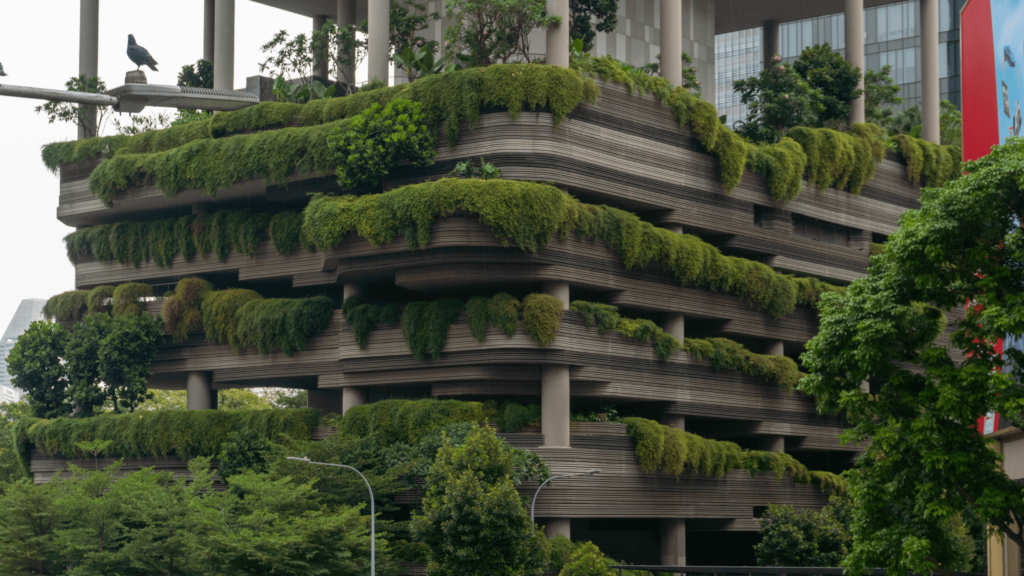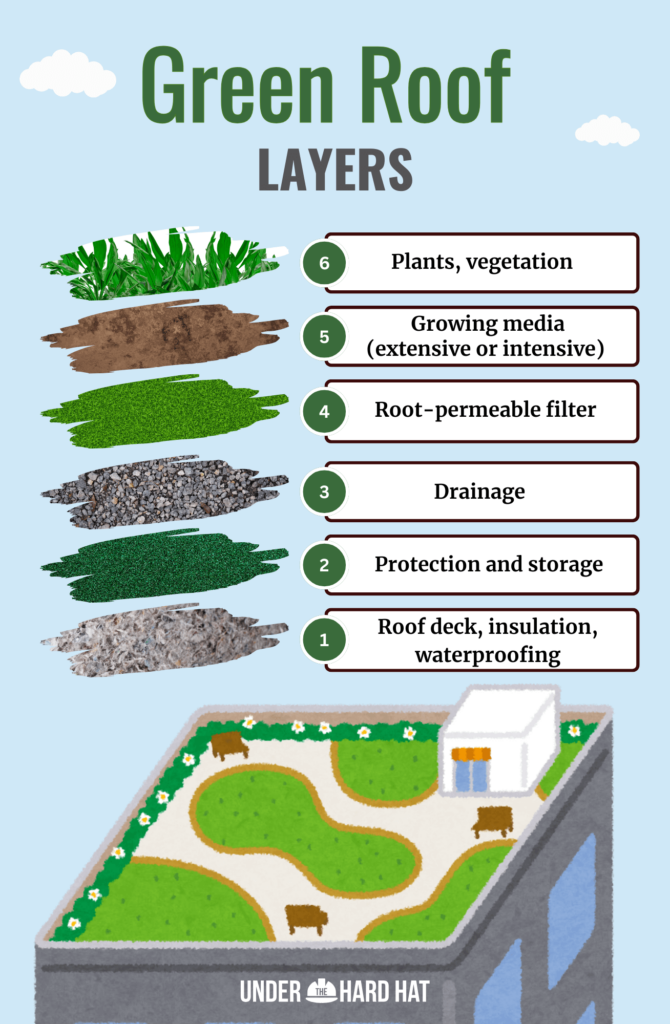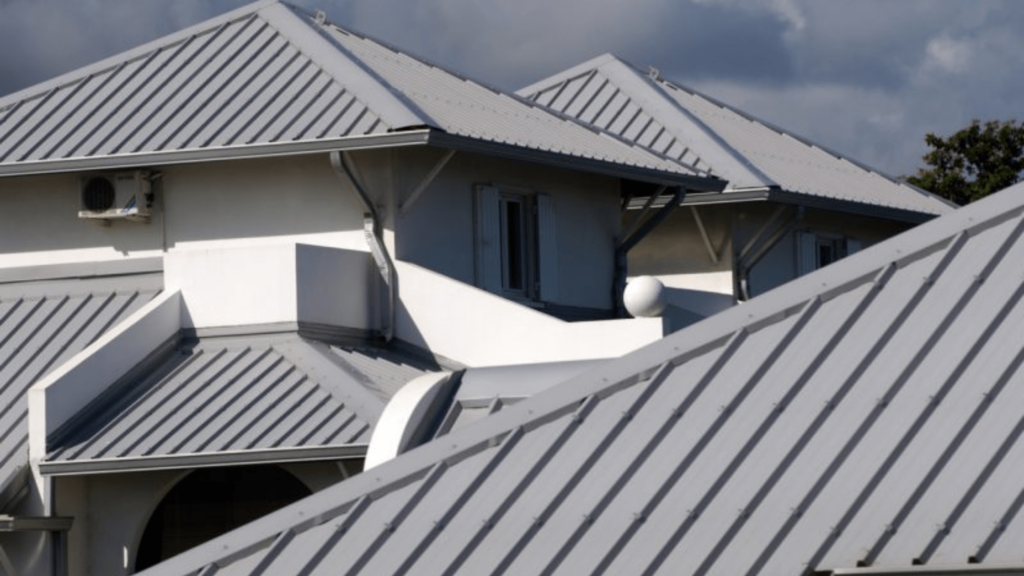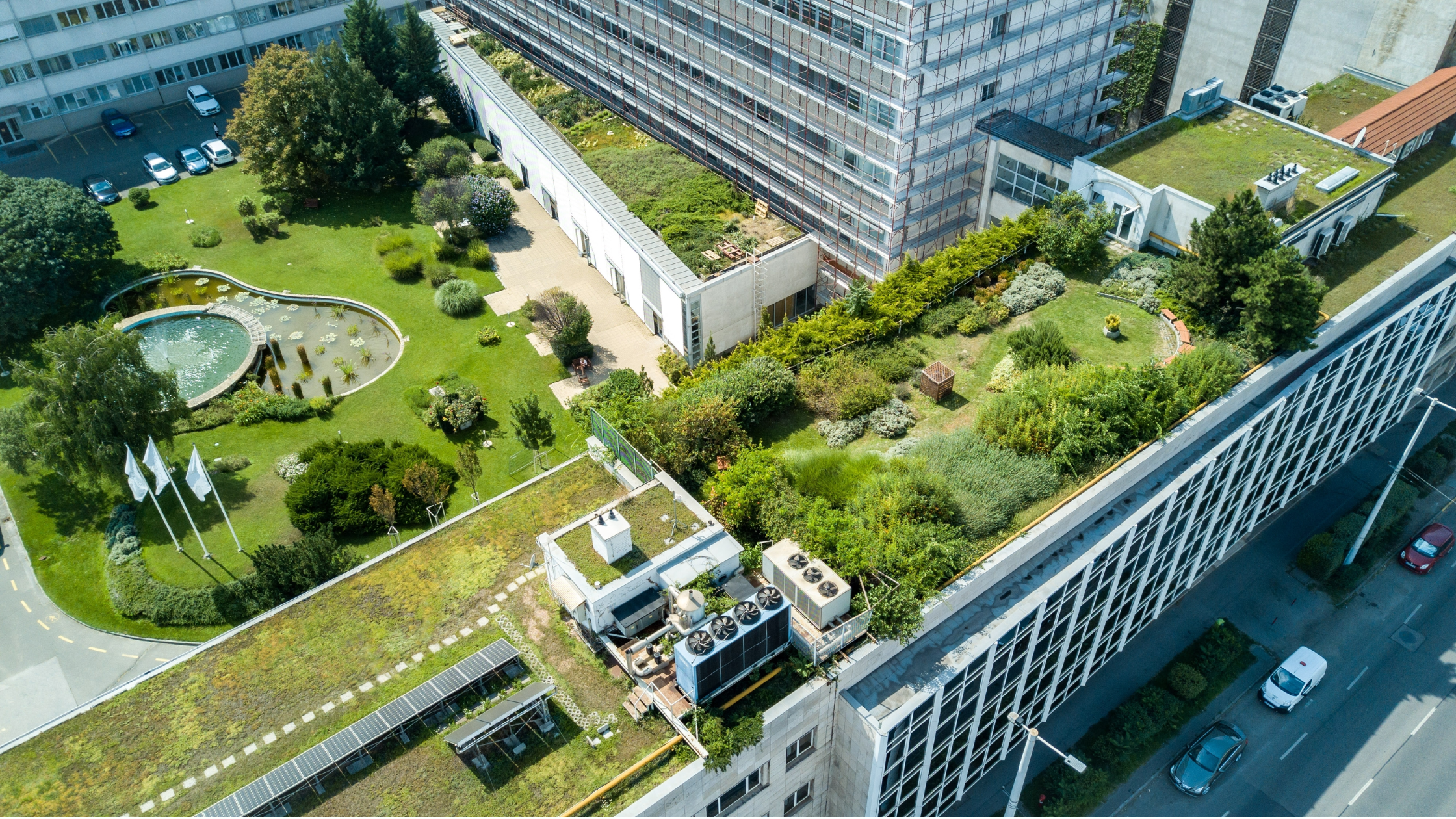Green roofs offer a practical solution for making buildings more environmentally friendly while enhancing urban spaces. Whether you’re interested in reducing energy costs, improving air quality, or supporting local wildlife, green roof benefits are plenty and can help you achieve these goals. However, they can be costly and require more maintenance than traditional roofs.
What are green roofs?

Green roofs are specially designed systems where vegetation is planted on a rooftop, creating a layer of living plants that provides environmental and practical benefits. These roofs are made up of several layers, including waterproofing, insulation, and a growing medium, all designed to support plant life while protecting the building underneath.
There are two main types of green roofs:
- Extensive green roofs: These lightweight systems with a shallow layer of soil (two to six inches) typically support low-maintenance plants like grasses and succulents. They are easier to install and require less maintenance but offer limited plant diversity.
- Intensive green roofs: These systems are more complex, with deeper soil layers (12+ inches) that can support a wide variety of plants, including shrubs and small trees. They require more structural support and maintenance but offer greater biodiversity and aesthetic appeal.
Here is a visual breakdown of the layers involved in a green roof:

Green roof benefits
Green roofs offer various environmental and practical benefits, making them an attractive option for residential and commercial buildings. Here are some key advantages:
Reduce heat islands
Green roofs help lower surrounding temperatures by absorbing and deflecting heat in urban areas. This cooling effect reduces the heat island effect, which occurs when cities become significantly warmer than rural areas due to concrete and asphalt surfaces that retain heat.
Improve drainage
By absorbing rainfall and slowing down runoff, green roofs help manage stormwater, reducing the pressure on urban drainage systems. This can minimize the risk of flooding during heavy rain and improve overall water management in cities.
Support wildlife habitats
Green roofs create a valuable habitat for local wildlife, providing space for birds, insects, and other creatures to thrive in urban environments. This enhances biodiversity and helps support ecosystems that urban development may otherwise disrupt.
Air quality
The plants on green roofs naturally filter air pollutants, improving air quality in cities. As they absorb carbon dioxide and release oxygen, they contribute to cleaner, fresher air, making urban spaces healthier to live and work in.
Energy savings
Green roofs act as natural insulators, reducing the need for artificial heating in the winter and cooling in the summer. This can lead to lower energy consumption and cost savings over time, making green roofs a more energy-efficient solution.
Noise reduction
The vegetation and soil layers on green roofs help absorb sound, providing a natural noise barrier. This is especially beneficial in busy urban areas, where green roofs can significantly reduce noise pollution for building occupants.
Aesthetic appeal
Beyond their functional benefits, green roofs add beauty to urban spaces. They transform otherwise dull rooftops into lush, green environments that can be enjoyed by both residents and the surrounding community, boosting the visual appeal of any building.
Green roofs vs. cool roofs

When choosing an eco-friendly roofing option, it’s essential to understand the differences between green and cool roofs, as each has advantages and drawbacks.
Green roofs
- Key features: Green roofs involve layering vegetation and soil on top of a building, creating a living, green space that offers insulation and environmental benefits.
- Benefits: Green roofs are excellent for reducing heat islands, improving drainage, enhancing air quality, and supporting wildlife. They also offer energy savings and noise reduction while adding aesthetic value.
- Drawbacks: Green roofs are typically more expensive to install and maintain due to their complex structure and ongoing care requirements. They also require strong structural support to handle the additional weight.
Cool roofs
- Key features: Cool roofs are designed with reflective materials that deflect sunlight and absorb less heat than traditional roofing materials, keeping buildings cooler.
- Benefits: Cool roofs are cost-effective, simple to install, and provide immediate cooling benefits by reducing heat absorption. They require less maintenance than green roofs and can be used on buildings that may not have the structural capacity for a green roof.
- Drawbacks: Unlike green roofs, cool roofs don’t offer insulation in colder months, nor do they contribute to improving air quality or supporting biodiversity. They are mainly effective for reducing heat and lowering cooling costs in warmer climates.
Consider your specific goals when deciding between a green roof and a cool roof. A green roof may be the best choice if you want broader environmental benefits and have the budget and structural support. If cost and simplicity are priorities, a cool roof may be more suitable, particularly in hot climates where reducing heat is the primary concern.
Things to consider before installing a green roof
Before committing to a green roof, it’s important to assess several factors that can impact the installation and long-term success of the project.
Cost
Green roofs typically involve a higher upfront cost compared to traditional roofing systems due to their complex structure and the need for specialized materials. Beyond installation, there are ongoing costs related to maintenance and potential repairs. However, these costs can often be offset over time through energy savings, extended roof lifespan, and environmental benefits.
Weight
Green roofs add significant weight to a building, so assessing whether your structure can support them is crucial. The weight of a green roof can range from about 13 to 35 pounds per square foot for an extensive system and 80 to 150 pounds per square foot for intensive systems (depending on soil depth, moisture content, etc.). As such, you may need to reinforce the roof to accommodate the additional load from soil, plants, and water retention. Consulting with a structural engineer is recommended before installation.
Maintenance
While some green roofs are relatively low-maintenance, others—particularly intensive ones—require regular care, including watering, weeding, and plant replacements. Extensive green roofs, which use drought-resistant plants, typically require less upkeep, but it’s still important to plan for ongoing maintenance to keep your green roof healthy and functional.
Climate
Your local climate will significantly impact the types of plants you can use and how well your green roof performs. Water retention may be less critical in wetter climates, while drought-tolerant plants will be essential in drier areas. The climate also affects the energy savings your green roof can provide and the system’s overall performance.
Plant choices
Selecting the right plants is critical to the long-term success of your green roof. Native species are often a good choice, as they tend to be more resilient and require less maintenance. In regions with limited rainfall, drought-tolerant plants can help reduce water consumption. Choosing plants appropriate for the depth of your green roof’s soil layer is also important.
Local regulations
Before installing a green roof, check local building codes and zoning regulations. Some areas may have specific requirements or restrictions, such as limits on the weight a building can support or guidelines for stormwater management. Furthermore, some cities offer incentives for green roof installations, such as tax benefits or subsidies to promote sustainable building practices. Understanding these regulations and incentives will help ensure your green roof is compliant and safe for your structure.
The bottom line
Incorporating a green roof into your building can offer significant environmental, economic, and aesthetic benefits. However, it’s important to consider factors like cost, weight, maintenance, and local regulations before installation. With careful planning and the right approach, a green roof can transform your space into a greener, more efficient, and visually appealing environment.



3 comments